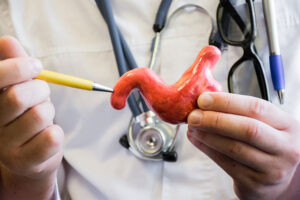Buried Penis in Children – Hidden Penis
Child Health

Buried Penis in Children – Hidden Penis
Cases of buried penis have increased considerably in the last ten years
Babies and children with buried penis should be distinguished from those with penis length at the lower limit of normal – this is certainly the doctor’s responsibility. When you press around the base of the penis and the penis emerges from the skin and its shaft becomes visible, this condition is called “BURIED PENIS” or “hidden penis” as it’s known in English. Cases of buried penis have increased considerably in the last ten years. Experts attribute this situation to improved socioeconomic conditions, increased access to information technology, lower threshold for consulting doctors, and increasing cases of childhood obesity. Families of children usually seek medical attention because they think their child’s penis is small, as in the case above. Less frequently, they also consult due to skin adhesions, burning during urination, or inflammation of the glans. While obesity-related conditions may occur, it can also result from inadequate development of penile fascia, which has been emphasized in recent years. It can also develop due to insufficient upper skin following circumcisions performed immediately after birth. Treatment is planned according to the severity of the burial and the child’s age. Here, doctors do not ignore possible sexual identity confusion and the child’s loss of self-confidence, and recommend surgical treatment to the family if necessary. In the above case, the child’s weight had hidden his penis, and additionally, the ligaments that push the penis outward had shortened slightly, and fusion (adhesion) problems had occurred between the structures we call fascia, but surgical treatment was not recommended. In recent years, doctors tend not to wait too long before recommending surgical treatment due to psychological disorders that are difficult to reverse.
What is Buried Penis?
In some children, the penis area may appear hidden within the fat located in the lower part of the abdominal region. This condition is called buried penis or hidden penis. The skin surrounding the penis generally shows an even distribution toward the scrotal area. However, some children may have a congenital hidden penis condition. In this penis appearance, there may also be tissue covering along with the skin surrounding the penis. Less skin is encountered toward the testicular area. In some hidden penis conditions, the penis may be hidden in the lower abdominal structure. The hidden penis condition seen in many children from birth corrects itself spontaneously in later ages. However, in some children, the appearance does not change as age progresses.
Click to learn about the most common childhood diseases.
Is Buried Penis a Disease?
Families may worry when they notice this condition. However, buried penis is not a disease. It is simply a condition that appears in appearance, and even if spontaneous improvement does not occur over time, a normal penis appearance can be achieved with treatment. Families should also know that the earlier treatment is started, the better it will be and faster progress can be made. However, hidden penis should never be viewed as a disease.

What Causes Buried Penis?
The hidden penis condition, called congenital in medicine, can result from many causes. The most common cause is having more fat tissue above the pubic bone than there should be. A reduction in this fat layer may occur with birth, and the hidden penis condition may resolve when children reach approximately 8 to 10 years of age. In some cases, this fat layer maintains its presence. Having less skin than necessary in the area of the penis close to the testicles is also among the causes of buried penis. Additionally, problems with the skin or fat tissue of the penis while the baby is in the womb can also cause babies to be born with buried penis. Buried penis is not only seen from birth. Sometimes incorrect circumcision cases can also bring this problem. In this case, expecting spontaneous recovery would be wrong. Usually, surgical intervention may be necessary.
Buried Penis After Incorrect Circumcision
As is known, circumcision is a surgical procedure that should be performed by physicians. If not done correctly, many different problems can arise. One of these is the buried penis condition. Not removing the skin from where it should be removed during circumcision, or removing more than necessary, can cause the penis to exhibit a backward retraction change. In some cases, tissue formation that will cause the penis to retract may also occur with wound healing after circumcision. All of these cause buried penis problems after incorrect circumcision.
What are the Types of Buried Penis?
In medicine, the buried penis condition is evaluated in 3 different categories. These categories are determined according to age and previous conditions.
- Concealed buried penis (present before circumcision)
- Trapped buried penis (appears with scarring after circumcision)
- Buried hidden penis (related to puberty and obesity)
In very rare cases, the penis shaft being attached to scrotal skin is also considered buried penis. In this buried penis form, the penis area appears turkey-neck shaped and is much shorter than it should be. This condition, also called webbed penis in medicine, occurs due to peno-scrotal webbing.
What are the Signs of Buried Penis in Babies?
- The penis being very small in size
- The area called foreskin swelling or expanding when the baby urinates
- Babies constantly dribbling urine
- Inability to direct urine correctly during toilet training
What are the Signs of Buried Penis in Adolescence?
- Difficulty holding the penis
- Difficulty maintaining hygiene
- Inability to direct urine flow correctly
- Pain
- Difficulty urinating
How is Buried Penis Treatment Performed?
Many buried penis diagnoses do not require treatment. It is among the problems with a very high probability of spontaneous resolution. However, if spontaneous improvement does not occur despite waiting for a certain period, it can be treated in three different ways.
- Application of anti-inflammatory medication to the penis area
- Pulling the skin called foreskin several times a day
- Surgical intervention
What are the Surgical Complications of Buried Penis?
- Just like the buried penis condition, most of the complications that may arise are also temporary.
- During the healing process, the scar tissue on the inner part of the skin may stick together.
- Extra connective tissue may form during the healing period. This fat tissue can cause the penis to retract inward again and cause buried penis to reoccur.
- Swelling may occur in the penis
- Fat tissue below the navel may reform
- Excessive growth may occur in the skin on the lower part of the penis
- Pain may occur during erection
- Poor graft healing may occur
- Excessive sensitivity may develop in the flap necrosis area
Psychology of Buried Penis in Children
Of course, the buried penis condition can cause psychological problems in children who have reached a certain age. The most common problem is children being ashamed of their bodies. For this reason, they may be reluctant to undress in changing rooms, not want to wear swimwear, or want to wear very loose clothing. It can also cause much more serious psychological problems such as isolating themselves from society. If a buried penis problem occurs, it is definitely recommended to resort to treatment methods. Along with this, psychological support should also be provided to children experiencing serious psychological distress.
What is the Difference Between Buried Penis and Small Penis?
Buried penis is a problem caused by fat tissue or skin tissue and largely resolves spontaneously. However, small penis is simply the penis being small in size. Spontaneous resolution is impossible. Small penis is also a treatable condition.















